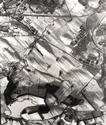 During the second half of the 20th Century Darnley has experienced total transformation from being a modest semi-rural community to becoming a significant part of Glasgow's response to a post-war housing shortage.
During the second half of the 20th Century Darnley has experienced total transformation from being a modest semi-rural community to becoming a significant part of Glasgow's response to a post-war housing shortage.
 Following the construction of large housing schemes at South Nitshill (1957) and Kennishead (1966), in 1968 the City of Glasgow approved the building of 2,048 homes in Darnley. This scheme was to occupy an area to the north of Nitshill Road covered by Leggatston Farm, part of the original Darnley estate taken within the City of Glasgow boundaries in 1938. Over three phases a total of 1,336 deck-access, two to seven storey apartment blocks were built. This fell short of the initial number planned owing to a combination of economic, political and management setbacks. It was intended that Darnley would be a largely self-supporting estate and for this reason two primary schools and a community centre formed part of the Council's plans. A social club and bowling green, a church, a small shopping centre and a library were all added throughout the 1970s.
Following the construction of large housing schemes at South Nitshill (1957) and Kennishead (1966), in 1968 the City of Glasgow approved the building of 2,048 homes in Darnley. This scheme was to occupy an area to the north of Nitshill Road covered by Leggatston Farm, part of the original Darnley estate taken within the City of Glasgow boundaries in 1938. Over three phases a total of 1,336 deck-access, two to seven storey apartment blocks were built. This fell short of the initial number planned owing to a combination of economic, political and management setbacks. It was intended that Darnley would be a largely self-supporting estate and for this reason two primary schools and a community centre formed part of the Council's plans. A social club and bowling green, a church, a small shopping centre and a library were all added throughout the 1970s.
 The broadening of the A726 to dual carriageway status in 1983 heralded the development of the Nitshill corridor as a light industrial and retail location. Darnley Trading Estate and large retail outlets clustered around the southward extension of the M77 (completed in 1997). The closure of Darnley Hospital in 1990 and the opening on the site of a £3million 120-bed nursing home in 1993 has also altered the employment opportunities for the local population and has become symptomatic of the regeneration of modern Darnley.
The broadening of the A726 to dual carriageway status in 1983 heralded the development of the Nitshill corridor as a light industrial and retail location. Darnley Trading Estate and large retail outlets clustered around the southward extension of the M77 (completed in 1997). The closure of Darnley Hospital in 1990 and the opening on the site of a £3million 120-bed nursing home in 1993 has also altered the employment opportunities for the local population and has become symptomatic of the regeneration of modern Darnley.